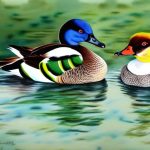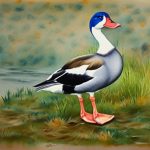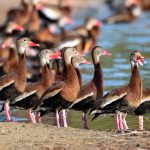Ducks are fascinating creatures with unique breeding habits that have evolved over centuries. Understanding these habits is crucial for anyone interested in duck breeding, whether for conservation, agriculture, or simply as a hobby. Ducks are known for their monogamous mating behavior, elaborate courtship displays, and dedicated parental care. Their breeding habits are influenced by a variety of factors, including environmental conditions, social dynamics, and genetic predispositions. By delving into the intricacies of duck breeding habits, we can gain a deeper appreciation for these remarkable birds and learn how to support their reproductive success.
Duck breeding habits are shaped by millions of years of evolution, resulting in a complex set of behaviors and adaptations. From the selection of mates to the care of offspring, ducks have developed a range of strategies to ensure the survival of their species. By examining the various stages of the breeding process, we can gain insight into the challenges and triumphs that ducks face in their quest to reproduce. Whether it’s the elaborate courtship displays of male ducks, the construction of intricate nests by females, or the diligent care provided to ducklings, each aspect of duck breeding offers a window into the natural world and the wonders of avian biology. In this article, we will explore the mating behavior, nesting and egg-laying process, incubation and hatching of ducklings, parental care, and the factors that influence duck breeding habits. By understanding these aspects of duck breeding, we can work towards the conservation and management of duck populations for future generations to enjoy.
Table of Contents
Key Takeaways
- Ducks are known for their diverse breeding habits, with different species exhibiting various mating behaviors and nesting preferences.
- Mating behavior of ducks involves courtship displays, pair bonding, and copulation, with some species forming monogamous pairs while others are polygamous.
- Nesting and egg-laying process of ducks typically involves finding a suitable site, building a nest, and laying a clutch of eggs, with some species laying eggs in the nests of other ducks.
- Incubation and hatching of ducklings are primarily the responsibility of the female, who diligently tends to the eggs until they hatch, at which point the ducklings are precocial and able to leave the nest.
- Parental care and protection of ducklings involve leading them to water, teaching them to forage for food, and defending them from predators, with both parents or the female alone providing care.
- Factors affecting duck breeding habits include habitat loss, climate change, hunting pressure, and pollution, which can impact the availability of suitable nesting sites and food resources.
- Conservation and management of duck populations involve protecting wetland habitats, regulating hunting activities, and implementing captive breeding and release programs to maintain healthy duck populations.
Mating Behavior of Ducks
Ducks are known for their complex mating behavior, which often involves elaborate courtship displays and rituals. Male ducks, known as drakes, will often engage in competitive displays to attract females and establish dominance within a group. These displays can include head bobbing, tail wagging, and vocalizations designed to impress potential mates. Once a female has been courted successfully, the pair will engage in a series of bonding behaviors, including preening each other’s feathers and engaging in synchronized movements. This bonding process helps to solidify the pair’s relationship and prepare them for the upcoming breeding season.
In some duck species, such as the mallard, males will form small groups known as “clubs” or “rafts” to attract females. These groups will engage in synchronized displays and vocalizations to attract females and establish dominance within the group. Once a female has chosen a mate, the pair will separate from the group and find a suitable nesting site. The mating behavior of ducks is a fascinating display of natural selection and evolutionary adaptation, with each species exhibiting unique strategies for attracting mates and ensuring reproductive success. By studying these behaviors, researchers can gain insight into the complex social dynamics and mating strategies of ducks.
Nesting and Egg-laying Process
After forming a pair bond, female ducks will begin the process of selecting a nesting site and laying eggs. Nesting sites can vary widely depending on the species, with some ducks preferring to nest near water while others may choose more secluded locations on land. Female ducks will construct nests using a variety of materials, including grasses, leaves, and down feathers plucked from their own bodies. The construction of a nest is a meticulous process that requires careful attention to detail, as the female must create a safe and secure environment for her eggs.
Once the nest is complete, the female will begin laying eggs at a rate of one egg per day until she has laid a full clutch. The number of eggs in a clutch can vary depending on the species, with some ducks laying as few as 4-6 eggs while others may lay upwards of 10-12 eggs. The eggs are typically white or off-white in color and are designed to provide protection and nutrients for the developing embryos. The nesting and egg-laying process is a critical stage in the reproductive cycle of ducks, as it sets the stage for the next phase of incubation and hatching. By understanding the intricacies of this process, researchers can gain valuable insights into the reproductive biology of ducks and develop strategies for supporting their nesting efforts.
Incubation and Hatching of Ducklings
Once a female duck has laid her full clutch of eggs, she will begin the process of incubating them to facilitate their development. Incubation periods can vary depending on the species, with some ducks requiring as little as 25-30 days while others may need 35-40 days or more. During this time, the female will remain on the nest to provide warmth and protection for her eggs, occasionally turning them to ensure even heat distribution. Incubation is a critical stage in the reproductive cycle of ducks, as it sets the stage for the hatching of healthy ducklings.
As the incubation period nears its end, the eggs will begin to hatch, with ducklings using their egg tooth to break through the shell. Once hatched, ducklings are precocial, meaning they are born with their eyes open and are capable of walking and feeding themselves shortly after hatching. The hatching process is an incredible display of natural adaptation and survival instincts, with ducklings relying on their innate behaviors to navigate their way into the world. By studying the incubation and hatching process, researchers can gain valuable insights into the developmental biology of ducks and develop strategies for supporting healthy hatchlings.
Parental Care and Protection of Ducklings
After hatching, female ducks will lead their brood of ducklings to water, where they will begin feeding and teaching them essential survival skills. Ducklings rely on their mothers for protection and guidance during this critical stage, learning how to forage for food and avoid predators. Female ducks are highly attentive parents, keeping a close watch over their brood and providing warmth and protection as needed. Male ducks may also play a role in caring for ducklings in some species, offering protection and guidance as they navigate their new environment.
Parental care is crucial for the survival of ducklings, as they are vulnerable to predation and environmental hazards in their early days. Female ducks will lead their brood to suitable feeding areas where they can find insects, aquatic plants, and other food sources essential for their growth and development. The parental care provided by ducks is a testament to their dedication to ensuring the survival of their offspring and passing on essential skills for future generations. By understanding the dynamics of parental care in ducks, researchers can gain valuable insights into the social behavior and reproductive success of these remarkable birds.
Factors Affecting Duck Breeding Habits

Duck breeding habits are influenced by a variety of factors, including environmental conditions, habitat availability, predation pressure, and social dynamics within populations. Environmental factors such as temperature, precipitation, and food availability can have a significant impact on the timing and success of duck breeding efforts. Ducks rely on suitable nesting sites with access to water and food resources to support their reproductive needs. Habitat loss and degradation can pose significant challenges for ducks, limiting their ability to find suitable nesting sites and raise healthy broods.
Predation pressure is another critical factor affecting duck breeding habits, as predators such as raccoons, foxes, and birds of prey pose a constant threat to nesting females and vulnerable ducklings. Ducks have evolved various strategies to protect their nests from predators, including selecting concealed nesting sites and engaging in distraction displays to draw attention away from their nests. Social dynamics within duck populations can also influence breeding habits, with competition for mates and resources playing a role in shaping mating behavior and reproductive success.
Climate change is another factor that can impact duck breeding habits, with shifts in temperature and precipitation patterns affecting nesting success and chick survival rates. By understanding these factors and their impact on duck breeding habits, researchers can develop conservation strategies to support healthy populations and ensure the long-term survival of these remarkable birds.
Conservation and Management of Duck Populations
Conservation efforts play a crucial role in supporting healthy duck populations and preserving their breeding habitats for future generations. Ducks face numerous threats to their survival, including habitat loss, pollution, climate change, and hunting pressure. Conservation organizations work tirelessly to protect critical wetland habitats, implement sustainable hunting practices, and raise awareness about the importance of preserving duck populations.
Wetland conservation is essential for supporting healthy duck populations, as these habitats provide essential nesting sites and food resources for breeding pairs. By protecting wetlands from development and pollution, conservationists can ensure that ducks have access to suitable habitats for raising their young. Sustainable hunting practices also play a role in supporting duck populations by regulating harvest quotas and protecting vulnerable species from overexploitation.
Education and outreach efforts are crucial for raising awareness about the importance of preserving duck populations and their breeding habitats. By engaging with local communities and stakeholders, conservation organizations can foster support for conservation initiatives and promote responsible stewardship of natural resources. Through collaborative efforts between government agencies, conservation organizations, and local communities, we can work towards ensuring that future generations have the opportunity to experience the wonder of duck breeding habits in their natural environment.
In conclusion, duck breeding habits are a testament to the remarkable adaptations and behaviors that have evolved over millions of years. From elaborate courtship displays to dedicated parental care, ducks have developed a range of strategies to ensure the survival of their species. By understanding these behaviors and the factors that influence them, we can work towards supporting healthy duck populations and preserving their breeding habitats for future generations to enjoy. Conservation efforts play a crucial role in protecting critical wetland habitats, implementing sustainable hunting practices, and raising awareness about the importance of preserving duck populations. Through collaborative efforts between researchers, conservationists, and local communities, we can work towards ensuring that ducks continue to thrive in their natural environment for years to come.
If you’re interested in learning more about duck breeding habits, you might also want to check out this informative article on chicken coop nest boxes. Understanding the nesting preferences of chickens can provide valuable insights into the breeding behaviors of ducks and other poultry. This article offers practical tips for creating a comfortable and suitable nesting environment for your birds, which can be beneficial for duck breeding as well.
FAQs
What are the breeding habits of ducks?
Ducks typically breed in the spring and summer months. They form monogamous pairs for the breeding season, and the male will often perform elaborate courtship displays to attract a mate.
Where do ducks build their nests?
Ducks build their nests in a variety of locations, including on the ground, in reeds or grasses near water, or even in tree cavities. They line their nests with down feathers to provide insulation for their eggs.
How many eggs do ducks typically lay?
The number of eggs laid by ducks can vary depending on the species, but it is common for ducks to lay anywhere from 8 to 12 eggs in a single clutch.
How long does it take for duck eggs to hatch?
Duck eggs typically take around 28 days to hatch. The female duck will incubate the eggs and care for the ducklings once they hatch.
Do ducks exhibit any unique behaviors during the breeding season?
During the breeding season, male ducks may engage in aggressive behavior towards other males as they compete for mates. Female ducks may also exhibit protective behavior around their nests and ducklings.
Meet Walter, the feathered-friend fanatic of Florida! Nestled in the sunshine state, Walter struts through life with his feathered companions, clucking his way to happiness. With a coop that’s fancier than a five-star hotel, he’s the Don Juan of the chicken world. When he’s not teaching his hens to do the cha-cha, you’ll find him in a heated debate with his prized rooster, Sir Clucks-a-Lot. Walter’s poultry passion is no yolk; he’s the sunny-side-up guy you never knew you needed in your flock of friends!







